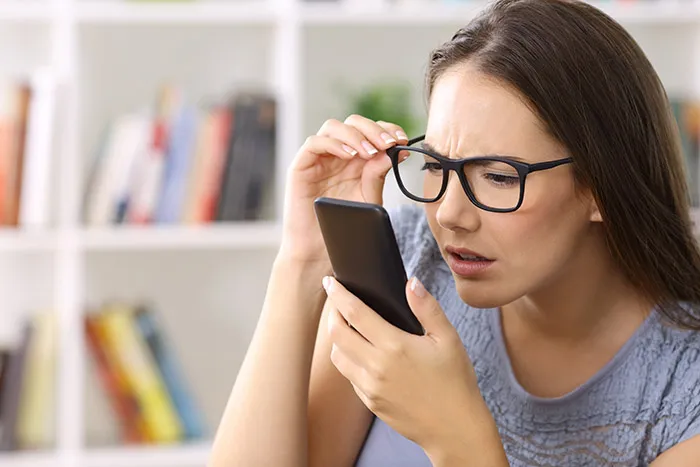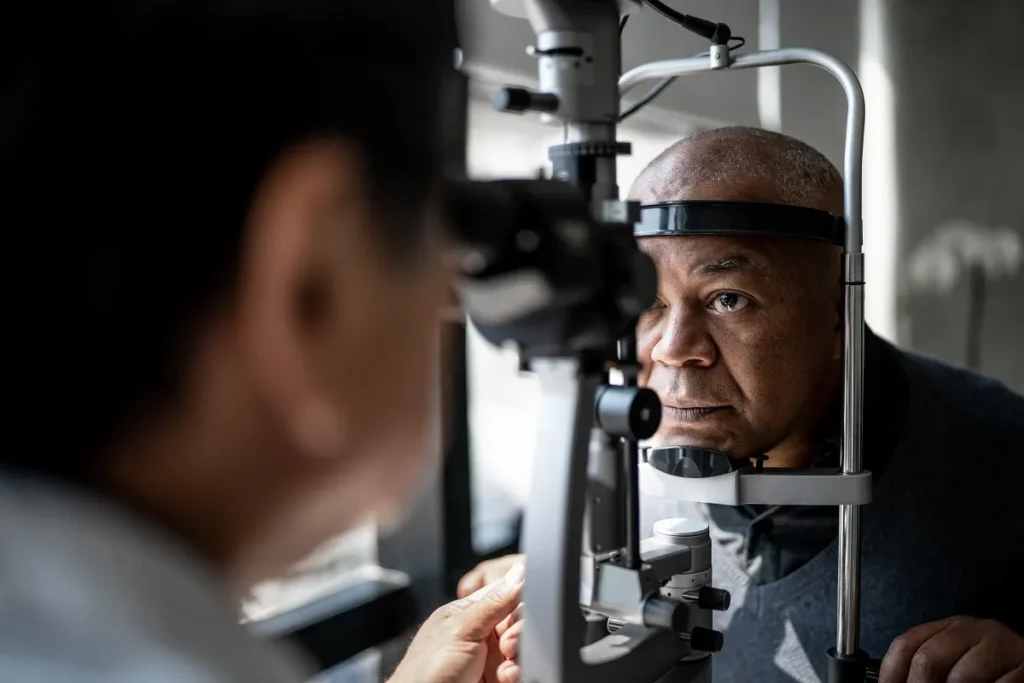Have you ever noticed trouble catching sight of objects that aren’t directly in front of you? If so, you might be experiencing peripheral vision loss.
In this blog, we’re diving deep into what causes this kind of vision loss, the signs you should look out for, and effective ways to manage it. So, keep reading to discover how to enhance your quality of life despite peripheral vision challenges.
Contents
Understanding Peripheral Vision Loss
Peripheral vision loss, often referred to as tunnel vision, occurs when you can no longer see objects on the side of your visual field while your central vision remains intact. This is distinct from central vision loss, which affects what you see right in front of you, impacting your ability to read, drive, or see details clearly.
Losing peripheral vision can make these daily activities more challenging and sometimes dangerous. It can feel as though you are looking through a narrow tube, where your field of view is significantly reduced, making it easy to miss out on things happening around you. This loss can lead to difficulties in mobility, increased risk of accidents, and a feeling of isolation.
Common Causes of Tunnel Vision
Peripheral vision loss can stem from several health issues. Here’s a straightforward list of common causes:
- Glaucoma: Gradually impairs the optic nerve, typically starting with peripheral vision.
- Retinitis Pigmentosa: A genetic disorder that degrades the retina, affecting night vision and peripheral sight.
- Stroke: Impacts areas of the brain responsible for processing visual information, potentially leading to peripheral vision loss.
- Brain Injuries: Trauma to the brain can damage areas controlling vision, affecting peripheral vision.
- Brain Tumors: Can press on the optic nerve or other parts of the brain involved in vision.
- Neurological Disorders: Conditions like multiple sclerosis can disrupt the visual pathways, affecting peripheral vision.
Symptoms to Watch For

When experiencing peripheral vision loss, the symptoms can vary. Here’s a list of key signs to monitor:
- Difficulty seeing in dim light
- Missing objects to your side when focusing straight ahead
- Bumping into objects that you didn’t see on one or both sides
- Needing to turn your head to see objects normally seen out of the corner of your eye
- A sensation of looking through a narrow tube (often referred to as ‘tunnel vision’)
- Frequent tripping or stumbling over objects not seen at your feet
- Sudden decreases in peripheral vision, which may seem like the curtains are drawing closed on the sides of your visual field
It’s crucial for anyone experiencing these symptoms to consult a healthcare professional for an accurate diagnosis and appropriate management.
Coping Strategies for Living with Peripheral Vision Loss
Living with peripheral vision loss requires adjustments to ensure safety and maintain independence. Here are practical tips to help manage daily activities:
- Lighting Enhancements:
- Increase lighting in your home to help illuminate paths and reduce risks of tripping or bumping into objects.
- Use nightlights in hallways, bathrooms, and bedrooms for better navigation at night.
- Home Organization:
- Keep walkways and frequently used areas clear of clutter to create obstacle-free paths.
- Use contrasting colors on walls, steps, and doorways to improve depth perception and outline spaces.
- Assistive Devices:
- Consider using mobility aids such as a white cane to detect obstacles in your path.
- Install handrails and grab bars in critical areas like staircases and bathrooms.
- Technology and Apps:
- Utilize apps and devices designed for the visually impaired, such as GPS apps that provide audio directions and feedback.
- Employ electronic magnifiers or text-to-speech software for reading and navigating screens.
- Safety Precautions:
- Apply non-slip mats in slippery areas like the kitchen, bathroom, and near entranceways.
- Label medications and household chemicals clearly with large print or braille.
- Social Support:
- Join support groups for people with visual impairments to share experiences and tips.
- Inform family and friends about your vision limitations so they can help arrange your environment for safety and ease.
- Regular Check-ups:
- Regularly visit your eye care professional to monitor your condition and adjust your coping strategies as needed.
Implementing these strategies can significantly enhance the quality of life, helping those with peripheral vision loss navigate their environment more safely and independently.
Modern Treatment Options for Peripheral Vision Loss

Managing peripheral vision loss involves a combination of medical treatments, surgical interventions, and lifestyle adjustments. Here’s a rundown of the current treatment options that can help manage and potentially improve this condition:
- Medical Treatments:
- Medications: Depending on the underlying cause, medications can help manage conditions leading to peripheral vision loss, such as glaucoma medications to reduce eye pressure.
- Vision-enhancing drugs: Some emerging therapies aim to improve blood flow to the retina or protect it from damage.
- Surgical Options:
- Laser Surgery: For conditions like glaucoma, laser treatments can help open drainage angles or reduce eye pressure, preserving peripheral vision.
- Vitrectomy: In cases where peripheral vision loss is caused by vitreous hemorrhage, this procedure can remove blood and scar tissue from the middle of the eye.
- Retinal Repair: Surgical interventions to repair retinal detachments or tears can prevent further loss of peripheral vision.
- Lifestyle Adjustments:
- Diet and Exercise: Maintaining a healthy lifestyle can improve overall vascular health, which benefits eye health. Regular cardiovascular exercise and a diet rich in antioxidants can support retinal health.
- Visual Aids: Specialized eyeglasses and adaptive devices like field expansion glasses can help individuals use their remaining vision more effectively.
- Environmental Modifications: Adjusting lighting, reducing hazards, and using high-contrast colors in living and workspaces can help maximize existing vision and prevent accidents.
These treatment options are tailored to individual needs based on the cause and extent of vision loss. Ongoing consultation with eye care professionals is crucial to choose the best treatment strategy and make adjustments as needed.
Conclusion
Your vision is invaluable, and maintaining your eye health should be a top priority. Peripheral vision loss can be unsettling, significantly affecting your daily life by limiting your ability to navigate your surroundings safely and independently. If you’re experiencing signs of vision changes or just want to ensure your eyes are in good health, don’t wait until it’s too late.
At Best Eye Hospital in India, we understand the importance of comprehensive eye care. Our team of experts is ready to provide you with the highest quality of service and the attentive care you deserve. It’s time to take action and safeguard your vision.
Book your free appointment today or give us a call at +91 9711116605. Let us help you keep your world in clear view!
FAQs
What deficiency causes loss of vision?
Answer: Vitamin A deficiency is most commonly associated with vision loss, particularly night blindness and severe dry eyes that can lead to more serious complications if untreated. Other nutritional deficiencies, such as vitamin E and zinc, can also impact vision health.
Is loss of peripheral vision a disability?
Answer: Yes, loss of peripheral vision can be considered a disability as it significantly restricts one’s visual field, which is critical for orientation, mobility, and the ability to perform daily tasks safely. It can qualify individuals for disability benefits and services depending on the severity and impact on their daily life.
Can stress cause peripheral vision loss?
Answer: While stress alone is not typically a direct cause of peripheral vision loss, chronic stress can exacerbate underlying conditions like glaucoma, which can lead to loss of peripheral vision. Stress can also lead to behaviors (like poor diet and sleep disturbances) that negatively affect overall health, including eye health.
Can dehydration cause loss of peripheral vision?
Answer: Dehydration itself typically does not cause permanent peripheral vision loss. However, severe dehydration can temporarily affect vision due to decreased blood supply to the eyes and other parts of the body. It’s important to stay hydrated to maintain optimal bodily functions, including eye health.
